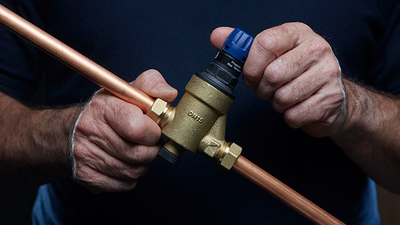5 top tips on how to get the most out of your outdoor plumbing

While installing outdoor plumbing, such as an outside tap, is considered to be an easy process, there are definitely some factors to keep in mind. Doing so will ensure that all internal and external water systems are balanced for a consistent and reliable water flow.
And here are RWC’s top tips for installation of outdoor plumbing, including how to keep your outdoor plumbing systems safe over the winter period.
1. Location is key
For any element of outdoor plumbing, location is one of the most important factors to bear in mind. Installers have to consider customer requirements as well as the accessibility to the water mains, as this will give the most reliable and consistent source of water. If this is unavailable, feeding off from cold-water tanks is a viable alternative. However, plumbers should note that this can drain existing water out of the system faster than it's being replaced and temporarily leave the house without running water, so it should be avoided where possible.
It is recommended to connect the pipe under the kitchen sink for easy installation. In addition to having access to a cold-water pipe that is directly connected to the water mains, there is usually enough space to feed the piping without worrying about concealing it once it is put in place.
2. Installation best practice
Installation from this point forward should be relatively simple, but some tips can help in avoiding any unwanted leaks and damage to your outdoor plumbing.
Before working on the cold pipe, ensure the mains water is fully shut off and not just isolated at the tap. It can be easy to accidentally tee off before the stop tap and cause unwanted leaks, so make a final check before beginning work on the pipe itself. Similarly, be sure to include an isolation valve such as the Mini Isolating Ball Valve from Reliance Valves, which allows for the easy maintenance of specific sections of the system, without having to shut off or drain the pipework. This allows the homeowner or installer to change the tap if required. This makes future work on the installation of outdoor plumbing simpler and causes less disruption to the home’s water whilst work is being carried out.
Once you are ready to drill into the wall, check for any cables in the plaster and drill a 22mm wide hole. This allows for a 15mm pipe and surrounding protective conduit to fit easily, whilst leaving enough room for the pipe to expand due to changes in temperature.
3. Make sure all hazards are isolated
It’s essential that all outside taps are fitted with a double check valve to prevent backflow and therefore water contamination. As it’s a legal requirement to install double check valves, taps usually come with one as standard but it’s still worth checking, just to ensure it is still installed safely and in line with all legislation.
Make sure the valve is fitted after the tee fitting before it passes through the wall to the outside tap to further isolate potential threats. If the isolation valve has been placed correctly, the water mains can be turned back on after installation of the outdoor plumbing, minimising the amount of time the house is without water.
4. Give the pressure a double-check
Mains water supply typically sits between 3-4 bars of pressure, which is too high for most irrigation systems as they can only handle 1.5 bar. If used with mains pressure, irrigation systems can be costly to run. This results in less efficient water distribution and even cause bursts in the system.
Make sure that a pressure reducing valve (PRV) is installed alongside an isolation valve, which will better regulate the pressure released from the tap. This will reduce the amount of water required, but also save the customer money on their water bills over the summer.

5. Winter is coming - Make sure the customer knows what to do
If a customer is not planning on using the outdoor tap over the winter period, installers should advise homeowners to turn off the mains supply via the stop valve and to fully open the isolation valve, which will ensure any standing water between the isolation valve and the tap is fully drained.
Removing the tap entirely is also best practice to ensure that there is no chance of damage to the system. It is also important to keep the installation process in mind when it comes to preventing burst pipes. The pipe between the isolation valve and the tap should ideally run vertically, so that water can properly drain out of the tap and not lie stagnant within the pipe. The two being level is acceptable, but the tap should certainly not be above the valve as this means the water will not drain out of the pipe properly.
Plumbers should also consider installing a drain off valve along with the isolation valve, this will drain any water in the pipes and prevent it from freezing during the cold. This can be supplemented with pipe insulation in unheated areas of the house, which will prevent any potential damage to the pipework from the cold.
Some alternative solutions would be to remove the outdoor taps entirely during the winter months, which would obviously prevent any freezing from happening, of course you would have to plug up the holes left in the wall too. Additionally, although not a very technical solution, simply putting a winter jacket over the outdoor tap reduces the risk of freezing tenfold.
Although these steps may sound simple to some, successfully installing an outside tap requires considerations, ranging from the tap's location to the products used. To help with this RWC offers a variety of solutions from our JG Speedfit, SharkBite and Reliance Valves ranges, which provide plumbers with products that are reliable, safe and quick to install.
To learn more about RWC’s family of brands visit our website, or to speak to a technical expert about outdoor plumbing, please click here.
Discover more
To learn more about RWC’s family of brands, or to speak to a technical expert, please click below.
